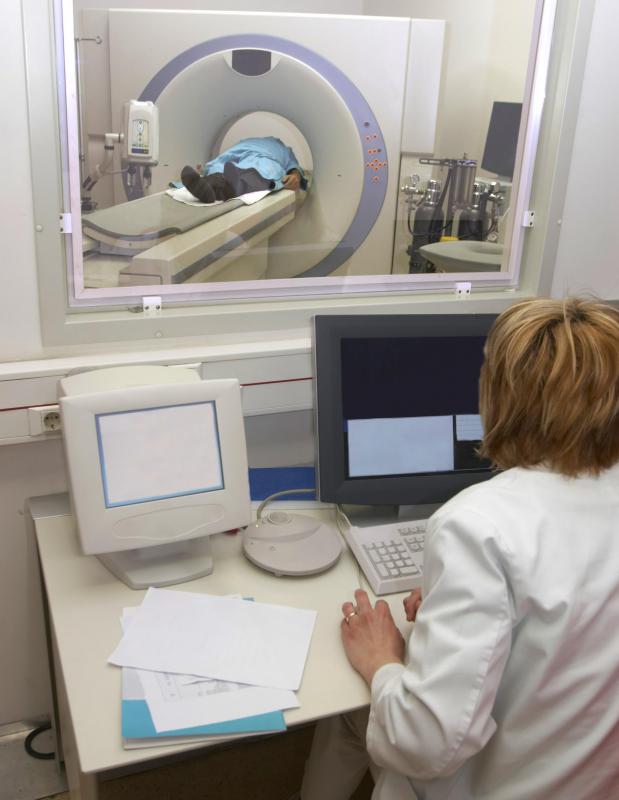At WiseGEEK, we're committed to delivering accurate, trustworthy information. Our expert-authored content is rigorously fact-checked and sourced from credible authorities. Discover how we uphold the highest standards in providing you with reliable knowledge.
What is Teleradiology?
Teleradiology is a practice where data from medical imaging studies is transmitted to a remote location for analysis and examination by a radiologist. Radiologists do not need to be on site with the patient to interpret test results, and teleradiology provides access to highly qualified specialists when they might not otherwise be available. Many medical centers use this service, and there are firms specializing in teleradiology services, with headquarters staffed by radiologists capable of reading imaging studies at all hours so they are available for emergencies.
In teleradiology, imaging is done on site with the patient, under the supervision of a radiology technician. The images are packaged for transmission and sent to a teleradiologist for examination. One potential use of teleradiology is in a hospital or clinic where a full-time radiologist is not available and patient films need to be read in emergencies and other situations. Radiologists can also transmit images to colleagues for a second opinion. In small communities where highly qualified specialists are not available, teleradiology provides residents with access to those specialists.

Along with the images, notes about the patient's situation are usually sent. The radiologist examines the images and considers them in light of the patient information, developing a report for use by doctors involved in immediate treatment of the patient. Non-emergency teleradiology can involve diagnostic examination of a wide range of images, along with examination of images to confirm the success of a treatment or to determine if a patient qualifies for coverage under insurance for a given procedure or condition.

People interested in working in teleradiology must attend school to become radiologists and may want to consider pursuing board certification and specialization to make themselves more employable. They can opt for regular hours in a facility or can choose to work unusual shifts, reviewing imaging studies in emergency situations where rapid turnaround is needed. Pay rates vary depending on degree of skill and the hours worked, and people may be eligible for employee benefits like health insurance as well.

One area where this practice has been tremendously helpful is in responding to disasters and providing medical treatment to people in remote, isolated areas. Getting radiology teams on the ground is not always possible in these settings, and the ability to transmit basic radiology images to someone in another location for interpretation can save lives and improve the quality of care. Telemedicine is an area of particular research interest for humanitarian organizations, as it allows them to deploy small rapid response teams backed by powerful resources.
AS FEATURED ON:
AS FEATURED ON:














Discussion Comments
@wavy58 – Believe it or not, this is actually not practiced just so hospitals can save money. There is a lack of licensed teleradiologists in the United States, so it is necessary to get help from people in other countries.
Unlike the outsourcing done in telemarketing businesses and in factories, teleradiology outsourcing is monitored very carefully. Only licensed teleradiologists are used, and they have to have a high quality of work.
My aunt is a teleradiologist, and she said that she is in no danger of losing her job because of outsourcing. There is just too much work for her to do on her own, so she isn't threatened.
I read that lots of teleradiology jobs are outsourced to other countries. Is this really safe? Are we getting the best care possible by doing this, or are hospitals just trying to save a few bucks?
I hope that my hospital doesn't do this. I'd like to know that a licensed technician is reading my x-rays correctly, and I just don't feel comfortable with my scans being sent overseas.
@Oceana – They use some sort of special software. I do know that they are scanned and sent electronically, but I have a feeling that the system is more advanced than just your typical scanner. Accuracy is very important in this situation.
How are the radiology images sent to another place? I'm guessing they aren't mailed, since this would take days, and the whole point is to get them to another person in a hurry.
Are they scanned and emailed? Is there some other method of transmitting them that would result in less potential blurring or loss of the images?
Post your comments